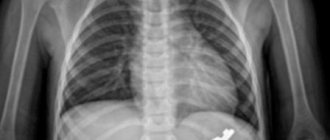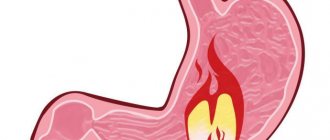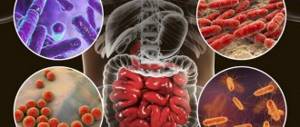How and why a pathological condition develops
Vomiting is a common unpleasant phenomenon in children, in which there is an uncontrolled release of stomach contents through the nose and mouth, accompanied by a characteristic sound.
This happens due to physical contraction of the abdominal muscles and diaphragm. Nausea often develops first; it is not accompanied by pain, but is very uncomfortable. Along with the contents of the stomach, liquid comes out in large volumes, so there is a risk of dehydration.
Only with the correct reaction of parents and the help of doctors can complications of this condition be avoided.
This disorder occurs as a response of the body to harmful toxins and substances ingested. It develops when:
- poisoning;
- infectious lesion;
- inflammation in the appendix;
- disruption of metabolic processes in the body;
- pathologies of the nervous system;
- overeating;
- consumption of large quantities of spicy, fatty foods;
- diseases of the gastrointestinal tract;
- inhalation of toxins;
- swallowing objects.
In infants, the gag reflex develops as a result of swallowing air while eating or putting fingers in the mouth.
Medicines for vomiting and nausea at home
There are a number of medications that will help you quickly restore normal well-being and get rid of the sensations that precede vomiting. Cerucal (the best remedy for nausea) and Metoclopramide cope most effectively with this task. Specialists often use the medicine in the treatment of most chronic ailments, which are dangerous due to their relapses. Cerucal and Metoclopramide help avoid dehydration, which leads to vomiting.
Important! Before taking medications, you should carefully read the contraindications and side effects. If nausea occurs against the background of any pathology, it will be possible to get rid of it only after complex therapy that will help eliminate the disease. During treatment, specialists prescribe medications that help facilitate the process of digestion and peristalsis.
In cases where the patient experiences disruption of the functioning of the endocrine system, a course of treatment with hormonal drugs should be taken. If the cause of nausea is parasitic worms that have entered the body, then nausea can be treated only after completing a course of treatment with anthelmintic tablets or suspension.
Types of pathological condition
Before you start stopping vomiting, you should determine its type:
- Functional - the safest . It is the body's reaction to food that is not suitable. If a child is vomiting without fever, this condition can be treated at home, subject to medical recommendations.
- Cardiac – develops against the background of heart failure, the skin turns pale, and appetite worsens. To stop this condition, only qualified medical assistance is required.
- Abdominal – develops due to inflammation in the abdominal cavity.
- Cerebral - develops in diseases of the brain, while the reflex is voluntary and most often appears in the morning.
- Psychogenic – develops due to a sharp change in the emotional background. This usually happens after eating; weakening, paleness of the skin and increased heart rate appear.
Diagnostic methods
To identify and eliminate the cause of vomiting, you need to undergo a comprehensive examination. During the examination, the doctor measures temperature, pulse, pressure, breathing rate, checks reflexes, assesses the degree of dehydration and the condition of the skin and mucous membranes. Be sure to palpate the abdomen and fontanelle, and record changes in weight.
Research methods:
- general and biochemical blood test;
- clinical urine analysis;
- Ultrasound of the abdominal organs;
- CT, MRI of the brain;
- examination of the stomach using an endoscope;
- X-ray of the peritoneum with contrast agent.
Based on the diagnostic results, a diagnosis is made, and the doctor makes a decision on hospitalization or outpatient treatment.
The main causes of vomiting
It is imperative to find out the causes of vomiting, and only then decide what to do. Some pathologies require strict dietary control . Without this, the condition will worsen and recovery will not occur for a long time.
In children, the body is more susceptible to negative influences from the outside and may react sharply to the inclusion of new foods in the diet.
The main reasons include:
- Acute food poisoning due to ingestion of spoiled or low-quality food. Failure to maintain personal hygiene can also cause acute poisoning.
- Poisoning by acids and alkalis, chemicals, medications or poisons. Children try to taste everything, so they put into their mouths whatever they can get their hands on. Such intoxication is very dangerous and can cause internal bleeding, cardiac arrest and a fundamental disruption in the functioning of internal organs.
- Indigestion, when the organ tries to push out food that irritates it. This happens when you overeat or include new unusual foods in your diet, as well as fatty or smoked foods.
- Intestinal infection - manifested by copious discharge of vomit , accompanied by watery diarrhea, fever, and abdominal pain.
- Congenital intolerance to certain foods. This happens when you react to lactose or gluten. But this condition is diagnosed already in infancy, which means that parents clearly know what food to choose for their baby.
- Acetonemic syndrome is a condition that develops with severe weakness of the body, with poisoning or intoxication. It is manifested by the simultaneous development of vomiting and diarrhea in the child - not everyone understands what to do in such a situation. At the same time, the mouth and urine smell of acetone. This condition is most often observed in children under 6 years of age, after which they outgrow it. But until it outgrows, it is necessary to treat the syndrome even with minimal manifestations.
Manifestations of intestinal infection are accompanied by profuse vomiting, weakness and dizziness.
- Inflammation in the digestive system - cholecystitis, gastritis, duodenitis, pancreatitis. Until about 15 years ago, medicine believed that the disease could develop in children only after 10 years. But in the modern world, due to the decline in food quality and poor environment, chronic forms of gastritis, for example, can be found in a two-year-old child.
- Peptic ulcer disease - with its development, the mucous membrane of the stomach and duodenum is injured, ulcers and erosions form on their surface. Sometimes the pathology manifests itself as early as 3 years of age or even earlier due to the negative impact of Helicobacter pylori infection on the body.
- Pathologies of the central nervous system - meningitis, cerebral edema, encephalitis, increased intracranial pressure. The vomiting process during the development of the listed diseases is accompanied by characteristic neurological signs, for example, headaches and dizziness, impaired consciousness, and convulsions.
- Rotavirus is a common disease in children and is accompanied by vomiting and fever . The degree of increase depends on the severity of the disease. Parents should clearly understand how to stop a child from vomiting due to rotavirus and quickly alleviate the child’s condition.
- Pyloric stenosis is a congenital disease when the sphincter of the stomach narrows, preventing a large volume of food from passing into the duodenum. The disease is mainly detected in infants up to one month old. It is characterized by profuse belching after each meal, when in the vomit you can see coagulated milk that has not been digested since the last meal.
- Sunstroke. Children do not fully develop proper thermoregulation, so the risk of heat stroke increases compared to adults.
- Acute forms of surgical pathologies – intestinal obstruction, appendicitis.
- With influenza or ARVI, too high a temperature provokes vomiting in children under 5 years of age . Also, pathologies are often accompanied by a strong cough to the point of vomiting in the child - many parents do not know what to do in such a situation.
- Gastrointestinal bleeding can also develop in children. The vomit in this state is dark, and the whole process is accompanied by diarrhea.
Antiemetics
Special medications - antiemetics - help stop severe vomiting attacks. The drugs differ in their action. It is necessary to take them only as prescribed by a doctor so that the condition does not worsen. There are three groups of antiemetic medications:
- central action - neuroleptics, antihistamines, dopamine and serotonin receptor blockers;
- peripheral influence - local antispasmodics, painkillers;
- mixed action - with a comprehensive solution to the problem.
Medicines help cure vomiting caused by diseases:
- neuroleptics - Triphasin, Aminazine - eliminate the symptoms of drug poisoning, are effective during pregnancy, radiation sickness, and in the period after surgery;
- antihistamines - Diprazine, Diazolin - cope with motion sickness caused by disturbances in the functioning of the vestibular apparatus;
- antiseptics – Enterofuril, Intetrix – destroy bacteria in infectious diseases of the stomach and duodenum.
Medicines selected for the treatment of certain pathologies can stop vomiting:
- migraine, traumatic brain injury - dopamine receptor blockers - Motilium, Zofrom;
- gag reflex during treatment and diagnosis by an ENT doctor - local anesthetic - Lidocaine;
- chemotherapy for oncology – Sertonon, Latran, Haloperidol;
- intestinal infections – Ersefuril;
- for a neurogenic cause of urge - Tenoten, Persen;
- universal medicine - Metoclopramide.
- Transvaginal ultrasound of the pelvic organs. How it is performed and how to prepare for intravaginal examination
- Tachycardia - what it is and how to treat it. Causes and symptoms of cardiac tachycardia and why it is dangerous
- How to present yourself at a competition
Central acting anti-vomiting agent
Drugs in this group have an inhibitory effect on the vomiting center, its chemoreceptor trigger zone located in the medulla oblongata. As a result, an impulse is not sent to the muscles that provoke the reflex effect. There are several types of centrally acting agents. These include:
- neuroleptics - Triphasin, Aminazine - used for poisoning, radiation treatment, pregnancy;
- antihistamines - Dimenhydrinate, Diphenhydramine - eliminate vomiting of vestibular origin.
Centrally acting agents include:
- Histamine receptor blockers, with a depressing effect on the central nervous system, accelerating peristalsis and bowel movements - Domperidone, Motilium. Medicines are prescribed for vomiting caused by infections, gastrointestinal dysfunction, and poor diet.
- Seratonite receptor blockers - Tropisetron, Latran - stop vomiting caused by gastric dyspepsia after surgery or chemotherapy.
Peripheral drugs
This antiemetic group of drugs acts at the level of efferent, afferent nerve endings involved in the mechanism of formation of the gag reflex. Peripheral medications include local anesthetics:
- Lidocaine, Benzocaine - used when performing otolaryngological manipulations - operations, treatment, bronchoscopy, anesthesia;
- Anestezin, Novocaine - help with vomiting caused by inflammation of the gastrointestinal tract, provoked by ulcerative processes.
Among the drugs of peripheral action are local antispasmodics. They are used for retching caused by disturbances in evacuation and motor function in acute and chronic inflammation of the gastrointestinal tract and biliary tract. Medicines include:
- Atropine, No-shpa, Papaverine, which have myotropic, anticholinergic properties;
- Bellasthesin is a combination drug that relaxes smooth muscles.
Mixed action
The popular antiemetic drug is effective for symptoms of various etiologies. A mixed-action medicine, Metoclopramide, quickly eliminates painful urges. The drug counteracts hiccups, activates gastrointestinal motility, stops the gag reflex caused by:
- poor quality food;
- traumatic brain injuries;
- pregnancy;
- release of bile;
- kidney pathologies;
- radiation sickness;
- chemotherapy;
- taking antibiotics, anesthesia drugs, cytostatics.
Metoclopramide, a dopamine receptor blocker, is used in the form of injections and tablets. For the drug, according to the instructions, the following are determined:
- dosage – tablet 4 times a day, half an hour before meals, do not chew, wash down with water;
- contraindications – intestinal obstruction, bleeding in the gastrointestinal tract, hypertension, old age, 1st trimester of pregnancy, children under 14 years of age, glaucoma;
- side effects - increased blood pressure, drowsiness, depression, tremors of extremities, diarrhea, anxiety;
- analogues - Cerucal, Clometol, Comportan, Bimaral, Primperan, Plastil.
What kind of vomiting happens?
The condition may indicate various pathological processes in the body; this will determine how to stop vomiting in a child. It happens:
Based on the appearance of vomit, one can draw initial conclusions about its causes.
- With an admixture of mucus - normal for infants , this is a common sign of overeating, and mucus comes from the bronchi and nasal cavity. At an older age, this should not happen and the causes of mucus inclusions can be serious poisoning, pathologies of the central nervous system, inflammation of the gastric mucosa, or damage to the body by viruses.
- With an admixture of bile , it acquires a yellow-green tint, leaving a bitter taste in the mouth. This is a clear sign of food poisoning or overeating, eating fatty and smoked foods in large quantities.
- With an admixture of blood - when inclusions of blood are found in the vomit, you should urgently call an ambulance, because such a condition indicates the development of internal bleeding of the upper esophagus. If the blood is scarlet, the pharynx or upper part of the stomach is damaged; if it is dark brown, the intestines are damaged.
The color of vomit and its meaning
During a single attack, the masses contain particles of undigested food, milk, minor admixtures of bile are allowed, any change in the color or consistency of the masses is a sign of serious pathological processes.
Analyzing color and consistency
- The color and consistency of the masses resembles coffee grounds, there are inclusions of blood - internal bleeding, ulcers, urgent hospitalization is required.
- The masses have a rich yellow tint - inflammation of the appendix, severe intoxication, intestinal infections.
- A large amount of bile, vomiting has a sweetish-bitter smell - malfunction of the gallbladder, liver, cholelithiasis.
- Green masses indicate neurological pathologies, severe stress.
- Vomiting water occurs with a cold or prolonged fasting.
- Foamy vomiting - occurs with acute intestinal infections, diabetes mellitus, meningitis, hepatitis, heart attack, and oncological pathologies.
- Fountain vomiting in infants is a sign of overfeeding.
Be sure to collect some vomit in a sterile container to show it to the doctor, this will significantly speed up and simplify the diagnosis, and the specialist will be able to quickly select effective methods of therapy.
What to do: first aid rules
Parents should not panic when their child is poisoned by vomiting. You need to decide what to do in your right mind, to assess the situation, try to remember what factors provoked the pathological condition. After calling a doctor, you need to follow the rules of behavior and understand how you can help:
- First of all, you need to provide the body with enough water . Children who are too young can be given a drink from a pipette or spoon to prevent dehydration. You should drink with special solutions, for example, one of the most effective drugs for mixing a solution is Regidron for children.
- When blood is found in the vomit, you can let the baby swallow a small piece of ice, and put an ice pack on the abdominal cavity - this will at least reduce the intensity of internal bleeding. But in such a situation it is forbidden to give drink.
- After relief occurs, you need to help your baby: rinse your mouth, wash your face so that stomach acid does not cause irritation.
- Medicines should be used with caution so as not to harm the body; it is better to use medications after examination by a doctor.
- Temporarily withhold food.
- Provide bed rest and comfort, place the baby on its side so that the contents of the stomach do not flow into the airways.
Dr. Komarovsky talks about how and what to feed a child in this state:
When to call an ambulance immediately
Sometimes it is simply impossible to treat such a disorder at home, the attacks do not end, and the baby is already exhausted. It is especially important to understand what to do if the child has vomiting, diarrhea and fever at the same time. In this situation, the help of a doctor is required.
The reason to immediately call a doctor should be:
- a strong increase in temperature that continues to rise;
- unpleasant odor, greenish tint of vomit, presence of blood streaks;
- diarrhea;
- convulsions;
- increased frequency of attacks.
How to stop vomiting in children by age
The vomiting process must be stopped in the following cases:
- A newborn spits up often and in large quantities - more than a tablespoon.
- Vomit contains mucus, bile and blood.
- The baby refuses any food. Information for parents if the child does not latch on to the breast.
- Uncharacteristic behavior – weakness, drowsiness.
- Paleness of the skin.
- Increased heart rate.
- Coldness of hands and feet.
- Severe pain.
This review describes in detail which antiemetic drugs are recommended for what age and how to use them correctly. Attention is also paid to folk remedies for relieving vomiting.
In infants under 1 year of age
When vomiting develops before the age of one year, you should definitely consult a doctor. Such a child is not able to explain himself what is wrong with him and what is bothering him. If the child does not sleep, you need to understand the reasons for this and take appropriate measures; more information is here. Self-medication can lead to disastrous results.
The main reason for the gag reflex in children under one year of age is the underdevelopment of the lower esophageal sphincter - this is the muscle that allows food to pass from the stomach to the esophagus.
Infants can often observe regurgitation of food, one of the reasons is weakness of the lower esophageal sphincter
Weakness of the sphincter can also manifest itself as abdominal pain and irritation of the throat mucosa. As you grow older, everything goes away on its own.
Sometimes a baby often spits up due to overfeeding, since the milk does not have time to be digested. This means you need to reduce the portions a little, then look at the body’s reaction.
When a pathological condition is accompanied by high fever and frequent loose stools, an infection has occurred. You need to urgently call a doctor or an ambulance.
In children after one year
After identifying the cause that requires stopping vomiting, you need to take the following actions:
- When a gag reflex occurs, the child is raised vertically - sitting or standing. The head is turned to the side to prevent the risk of choking.
- After an attack, you can rinse your stomach with a weak solution of potassium permanganate or at least warm boiled water.
- To replenish the fluid supply in the body, you need to drink a lot - it is better to use special solutions for this purpose.
- If the pathological condition is a consequence of food poisoning, then activated carbon, Enterosgel, Smecta will help remove the remaining toxins.
- When a child has vomiting and fever, this is an alarming symptom. It is imperative to contact your doctor. In this condition, it is forbidden to give antipyretics - they will come out along with the vomit. It is better to use injections or rectal suppositories.
When is it forbidden to stop gagging?
Vomiting is a protective reaction of the body to the penetration of toxins and other unnecessary substances. Therefore, in case of poisoning, it is forbidden to prevent vomiting until it becomes transparent.
The vomiting process is not dangerous, but harmful substances can cause great harm if they remain in the body. There is no need to give antiemetic medications until the gastric secretions become clear.
You should also not purchase questionable drugs; you should always consult a doctor before use.
When to see a doctor urgently
If you ignore this symptom and poor health, this will lead to undesirable health consequences. Signs that are an alarming sign that require complex treatment:
- With severe pain in the abdominal area;
- The condition does not improve, the nausea does not go away;
- Discharged masses with bile, bloody spots;
- Nausea is accompanied by diarrhea;
- The stomach does not accept food, frequent vomiting began;
- High body temperature lasts all day, convulsions appear;
- Fainting;
- The child continues to vomit profusely.
It is necessary to treat the stomach after diagnosing the disease and consulting a doctor. Responding to symptoms promptly will help keep you healthy.
State normalization rules
In order to stop vomiting in a child at home, it is permissible to use special medications. It should be stopped only when the frequency exceeds 3 times per hour or when there is mucus or blood in it.
First of all, you need to worry about maintaining water balance, because... If a child vomits, dehydration may occur
- To solder children of any age with the development of vomiting, you can use the drug Regidron with many minerals and other useful components in the composition. It quickly restores the ratio of missing microelements, normalizes the functioning of organs and systems, and balances the microflora. It is produced in powder form for dissolution in 1 liter of water. The amount of solution for use is calculated according to the formula - 10 ml per 1 kg of body weight.
- If you don’t have a solution at hand, it’s acceptable to drink Borjomi or Essentuki mineral water. Having previously released the gas.
- To remove toxins, you need to use medications with an absorbent effect - activated carbon, Smecta, Atoxil, etc.
- If vomiting develops during the day, but there has not been a single bowel movement, this process needs to be induced. An excellent children's remedy are glycerin suppositories.
- After 5 years, you can give drugs to restore the functions of the digestive tract - Motorix, Mezim, Pancreatin.
- When you can’t stop vomiting, you should call an ambulance. Usually, in this situation, doctors give a one-time injection of the drug Cerucal. This immediately stops the pathological process and allows the patient to be examined.
- Motilium has a good effect on the condition after vomiting. It stimulates intestinal function and improves the process of gastric emptying.
- If an intestinal infection develops with vomiting and diarrhea, Enterofuril tablets are prescribed. This is an intestinal antiseptic that kills pathogenic bacteria in the lumen of the organ. Thanks to this, the drug helps cure infection in children and adults. Enterofuril only destroys pathogens, but does not help replenish lost fluid, so it is used together with solutions.
- Motilak will quickly stop the vomiting process. It has an antiemetic and prokinetic effect for any origin of nausea and vomiting.
- Phosphalugel quickly helps when the vomiting process is accompanied by severe abdominal pain. The product absorbs, neutralizes acids, and envelops the mucous membrane. It also reduces the activity of hydrochloric acid and pepsin, maintaining normal digestion and preventing the re-release of stomach contents.
Folk remedies for children and adults
Products based on natural ingredients will help eliminate the vomiting process at home. You can make infusions and decoctions using herbs and plants. The easiest way is to let the person smell ammonia. If you have problems with the vestibular system, dissolve Validol under your tongue and hold a slice of lemon in your mouth. Folk remedies for vomiting in adults and children:
- a teaspoon of apple cider vinegar per 100 ml of water - drink until the urge disappears;
- decoction of valerian root – 20 g per glass of boiling water – take 10 ml twice a day;
- a spoonful of potato juice - for persistent urges.
The following recipes will help stop a child’s gag reflex:
- beat the yolk and 100 ml of low-fat milk, give a teaspoon every hour;
- steep brew of green tea without additives, with sugar - 5 ml after an attack, 30 ml - after 15 minutes;
- a decoction of lemon balm, mint, chamomile - a spoonful in a glass of boiling water, leave for an hour in a thermos, strain, drink in small sips between urges.
Tea with ginger and a slice of lemon
Ginger root helps to cope with the gag reflex. The plant is consumed by adding to drinks, or chewing a small piece. Tea made according to the following recipe will help stop vomiting:
- base – half a liter of boiling water;
- add 1 spoon of green tea;
- the same amount of chopped ginger;
- put 2 slices of lemon;
- keep covered for 10 minutes;
- strain;
- drink, adding honey, during the morning.
Peppermint tincture
Peppermint helps to quickly stop nausea and vomiting, especially during pregnancy. The plant contains menthol, tannins, bitterness, flavonoids, and essential oil. Mint makes breathing easier and has a refreshing taste and aroma. Half the serving should be drunk immediately; if the condition does not improve, then consume the rest after an hour. To prepare a water tincture you need:
- take a glass of boiling water;
- put 2 tablespoons of dry mint leaves into it;
- leave for 30 minutes;
- strain.
Quince baked in the oven
The fruits of the plant contain organic acids, microelements, large amounts of vitamins, and fiber. All this helps to remove toxins, heavy metal salts, and radioactive substances from the body. It is not recommended to use java if you have a stomach ulcer or enterocolitis - there is a possibility of spasms and intestinal blockage. To stop vomiting, you can drink fruit juice. Traditional healers give a recipe:
- cut the quince;
- remove the seeds from it - they contain poison;
- bake in the oven;
- make puree;
- use little by little to stop the urge.
Decoction of dill or fennel seeds
Seeds of medicinal plants help stop vomiting. Fennel eliminates discomfort due to its effect on the mucous membranes of the gastrointestinal tract; the seeds can be chewed and a decoction can be prepared from them, which is drunk in a glass in the morning on an empty stomach. Dill is no less effective antiemetic. Useful remedies from these plants are prepared according to one recipe. Necessary:
- take a spoonful of seeds;
- pour a glass of boiling water;
- stand for 10 minutes;
- cool;
- strain;
- take with the addition of honey.
What to do if you have persistent vomiting
Vomiting in a young child is very dangerous due to the risk of dehydration . Most often, parents cannot independently determine the reasons. It is recommended to call a doctor or ambulance immediately after development.
Parents must know the first rules of how to stop vomiting in a 3-year-old child on their own. But if attempts are not successful, then you need to urgently call a doctor. Especially if a rare, intense deterioration of the condition occurs, cramps and diarrhea develop.
The doctor determines the cause and specifies the pathology. Even if a child is vomiting without fever, what to do in such a situation should be decided by a specialist. You won’t be able to do anything at home on your own, and you can’t hesitate.
What to do after assistance has been provided
After the attack stops, the child is carefully examined by a pediatrician. In case of poisoning or in a mild condition, treatment at home is allowed , being sure to follow all the doctor’s recommendations.
Treatment is as follows:
- Drawing up a suitable menu, excluding spicy, fatty, smoked foods. Products should be light and easily digestible. You need to feed a little, but often. If you have a baby, we recommend that you read the reasons for loose stools in a child in this article.
- Drink plenty of water - plain water, alkaline mineral water, a solution based on Regidron and weakly brewed black tea.
- Taking enzymes is needed to restore digestion.
- Taking probiotics helps restore intestinal microflora.
- Taking antispasmodics is required to relieve intestinal colic and abdominal pain.
- Taking sorbents - they need to be taken for some time after attacks in order to remove remaining toxins from the intestines.
Prevention
The main rule of prevention after completion of treatment is personal hygiene. You should always wash your hands before eating, and start feeding no earlier than 5 to 7 hours after the last attack.
Breast milk is best suited for restoring a baby’s body, and when a child vomits at 3 years of age or older, rice or buckwheat with milk, fruit and vegetable purees.
Food should be semi-liquid, boiled or baked so that nausea does not recur. Ideal helpers during the recovery phase are soups, natural juices, and lean meats.
conclusions
There are many known causes of vomiting in children. If it develops, you should seek help from a doctor, since it is not always possible to determine the cause on your own, and the chosen treatment can cause great harm.
You can use antiemetics only after consulting a pediatrician, as they provoke many side effects. Before the doctor arrives, it is allowed to give sorbents and water. In addition to the article, watch a visual video that tells you how to quickly stop vomiting in a child.
One of the tea recipes, which is recommended to be given when vomiting, is described in this video:
Medication methods
Today, pharmacies offer a wide selection of antiemetics that have different effects on the body. Each of the drugs has its own scope of action. Depending on the pharmacological group, the following types of drugs that help stop nausea are distinguished:
- M-cholinergic receptor blockers - medications act on the peripheral nervous system, reducing its activity. Drugs in this group include Meterazine, an effective tablet for motion sickness. The active ingredient of the drug is prochlorperazine. Take the product after meals with water. Safe dosage is limited to 4 tablets per day. The list of side effects of the drug is headed by drowsiness and dizziness. It is not recommended for persons with impaired liver function, heart disease, or vascular diseases.
- Centrally acting anti-nausea medications directly relieve the vomiting center of the brain. These include the antihistamine Diprazine. The active substance promethazine reduces stimulation of vestibular receptors and has a sedative effect. Take the medicine once an hour before the trip, children - 10-20 mg, adults - 25-50 mg. The drug is not prescribed to pregnant women, people with allergies to components, or people with heart, liver, bone marrow or brain diseases.
- Antiemetics of mixed action, blocking central and peripheral receptors, reduce the activity of the gastric outlet and stop the reflux of intestinal contents. This group includes Metoclopramide, an effective and cheap drug suitable for stopping vomiting in children. It is not effective in treating nausea of vestibular origin. Available in the form of tablets and solution for injections. Dosage for adults: 0.01 g three times a day.
- Histamine H1 receptor inhibitors are drugs that reduce the amount of histamines in the blood that cause irritation of the vestibular apparatus. Pipolfen is widely used by travelers to help with motion sickness. The active substance of the drug, promethazine hydrochloride, is considered fast-acting - it stops nausea within 5-10 minutes after administration and lasts for 4-12 hours.
Adults take 1 tablet before the trip, drinking 1 tablet every 4-6 hours if necessary. Side effects of the drug include drowsiness, apathy, loss of energy and decreased blood pressure. It is not prescribed to chronic hypotensive patients, persons suffering from bradycardia, impaired transmission of nerve impulses, pregnant women, and children under 6 years of age.
- Sorbents (substances that remove toxins from the body) are used for vomiting caused by too much food, medicine or other drugs entering the stomach. The most famous drug in this group is activated carbon. In case of poisoning, gastric lavage is prescribed with a solution of 1-2 tablets per glass of water. After this, charcoal is taken at the rate of 4-8 tablets three times a day, treatment lasts several days. Long-term use of charcoal can lead to hypovitaminosis; it is contraindicated for internal bleeding and peptic ulcers.











